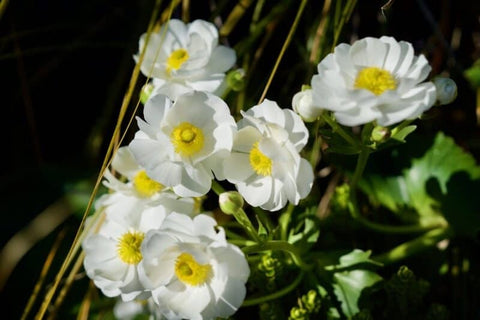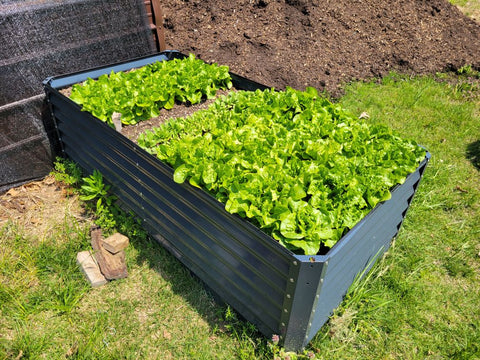Growing and harvesting your own vegetables and herbs is one of the best things about the warm summer months. But cold weather doesn't mean the growing season is over. With some basic knowledge and equipment, you can grow fresh vegetables in the winter, overwintering crops, and get a head start in the spring.The following content also has some reference value for raised garden beds.
Here's everything you need to know about growing vegetables in winter.
What is Winter gardening?

As autumn temperatures drop, so do our summer gardens. While heat-loving vegetables like tomatoes, peppers, and eggplants can't survive cold temperatures, many cold-season crops can withstand late fall frosts or survive outdoors until spring.
Other crops, especially lettuce and other greens, can be grown outdoors in a protective cover, even in winter, or in an unheated greenhouse. You can also get the earliest spring crops by overwintering plants or winter sowing.
Know your hardiness zones
The first step in planning a winter garden is to understand the USDA's hardiness zones. This name will let you know which plants can survive in your area at different times of the year. Each state has several hardiness zones, so be sure to consult the USDA's Hardiness map to make sure you know the hardiness zones in your area. Be aware that climate change may mean that your area has become warm enough to grow some plants that could not grow there before.
Check your first and last frost dates
Once you've identified your hardiness zone, you'll want to check your area for the first and last frost dates. This information will help you grow the right plants at the right time, which is key for season extension and winter gardening. It's important to know that these dates are estimates based on historical data, so be sure to check your local weather forecast before planting.
Once you know the first frost date of fall, you will know which plants in the garden will be damaged by frost and should be harvested, and which plants can survive outdoors, with or without protection. Knowing the average last frost date in spring can help you know when to plant seeds for cool crops indoors or outdoors and when to plant seedlings outdoors. Seed packaging usually indicates when to start sowing or sowing outdoors related to first frost and late frost dates.
How to protect vegetables in winter
In all but the warmest regions, growing vegetables in winter requires some extra protection. Season extension methods such as low tunnels or circles, cold frames, clocks, unheated greenhouses, and even simple mulches can protect vegetables and ensure a winter or early spring harvest. Here are some of the best ways to protect your vegetable garden in winter.
Use low tunnels or multiple tunnels
Covering plants with some kind of protective material is one of the best protections against frost and freezing temperatures. This can be as simple as a layer of floating row mulch, or putting Reemay(a polyester gardening material) on your bed before the first frost in the fall.
The use of plastic rings, sometimes referred to as low channels or multi-channels, if coated with plastic, ensures that mature plants have enough space and will not be damaged by mulch. In cooler climates, you'll need to double down on floating row covers to prevent extreme frosts. In very cold climates, cover the hoop with a plastic sheet to create a multi-channel, which can increase the temperature by 30 degrees Fahrenheit.
Tips

Be sure to tie or compress the drain cover or plastic wrap to prevent cold air from entering and ensure your plants are protected.
Using cold frames
A cold frame is a low, portable structure with a clear lid that can be placed on a garden bed to create a warm microclimate and protect plants from the cold. The cold frame can also be fixed so that plants can be seeded directly inside the cold frame. They can be built with old Windows, plexiglass, straw bales, or wood, or you can buy ready-made cold frames that resemble small greenhouses.
On sunny days when the temperature is above 40 degrees Fahrenheit, it is important to open the cold rack a few inches to avoid overheating the plants. Just be sure to turn it off again later in the day when the temperature drops.
Use structure
The clock is a transparent covering that can be draped over individual plants or an entire garden bed to protect plants from the cold. Clocks can be made of plastic or glass; Individual plants can be protected using clocks made from upcycled plastic bottles or milk cans. The clock can also look like a whole mini greenhouse or multi-channel. Clocks are especially useful for protecting individual plants from frost in late fall or early spring.
Use greenhouse
If you have the space and budget, an unheated greenhouse can be a great winter gardening solution. Greenhouses can be made of glass or plastic and built into wood or metal frames. You can also buy or build a structure called a ring house, or a tall tunnel that covers an entire garden or garden bed. In order to reduce the heat loss in the greenhouse, water tanks can be placed in the greenhouse to increase the heat. They absorb the sun's heat during the day and release it at night, preventing the indoor temperature from falling too low.
10 kinds of vegetables grown in winter
Many cool season vegetables and herbs can be planted in late summer or fall and then overwintered into early spring. Other vegetables can survive into winter through season-extending techniques that taste sweeter when harvested in the spring: As temperatures drop, vegetables such as carrots, beets and hardy vegetables convert starch into sugar to protect them from frost. Leafy greens grow quickly and can be sown and harvested outdoors in winter if protected. Here are some of the best vegetables to grow in winter.
beet
Plant beets six to eight weeks before the last frost in the fall and overwinter them under mulch or plastic row covers for harvest in the spring. You can also grow beets for their green color rather than their edible roots. Plant small salad vegetables once every two weeks in a greenhouse, cold shed, or low tunnel covered with plastic.
arugula
Zesty arugula is a fast growing crop that thrives in cool spring or fall weather. Sow arugula seeds in a cold frame six weeks before the first frost date. Protect plants with a wall clock before the frost sets in, or use a wreath with a floating row lid or plastic. You can also grow arugula in a greenhouse. Plant the seeds every two weeks so that you can harvest continuously throughout the winter.
kale
Start sowing this hardy green crop in early fall until your first frost date. Use floating row mulch or cold frames to protect kale plants from frost and snow. With protection, kale can survive until spring.
The grass
Hardy perennial herbs, such as rosemary, sage, thyme, and lavender, can withstand winter temperatures and regrow in the spring, except in the coldest USDA hardiness zones. If you want to harvest in the winter, cover the plants with a row lid or plastic wrap before the last frost date, or move the container plants to an unheated greenhouse. Soft herbs like parsley, sown in warm weather, can be protected with row covers, low tunnels, or cold frames to survive the winter in cold weather. Other soft herbs, such as leeks, are grown in containers that can be brought indoors or put in a greenhouse for the winter.
carrot
Plant carrots in late summer to give them time to grow, as they won't grow much after the cold weather hits. Leave some good-sized carrots in the ground for the winter and cover them with a few inches of salt hay or straw to insulate them from the cold. Harvest as needed throughout the winter, or wait until early spring to dig up the crop.
cabbage
For overwintering cabbages, sow seeds of hardy varieties in late summer. Depending on your planting area, you can leave the plants as they are or protect them with floating row covers or plastic sheeting when frost comes. You can also sow cabbage in a cold frame or greenhouse as a salad or small green vegetable to cook all winter long.

garlic
In mid-fall or late fall, plant garlic cloves before the ground freezes. From late winter to early spring, garlic sprouts and continues to grow until mid-summer, when it is ripe. Green leaf garlic can be harvested and cooked as green garlic or spring garlic. Otherwise, let the garlic grow and harvest in mid-summer.
spinach
Plant hardy spinach varieties like "Bloomsdale" six weeks before the first frost so the plants can grow. If you want to harvest in the winter, use floating row mulch or plastic wrap over a low fence to protect the plants. You can also leave the spinach unprotected and let the leaves die, and they will regrow in early spring. Spinach can also be sown in a freezer or greenhouse and the greens harvested in winter for baby salads. For continuous harvest, plant seeds every two weeks.
lettuce
Fast growing, hardy lettuce is one of the best ways to grow vegetables in winter. If you plan to plant hardy varieties of lettuce two to three months before the first frost date, or six weeks before the last frost date in the greenhouse or freezer, such as "Arctic" or "Loro Rosso." Harvest as needed throughout the winter. You can also sow lettuce in a greenhouse or freezer six weeks before the last frost, then plant it every two weeks for a continuous harvest.
Swiss chard
Plant Swiss chard in late summer or early fall, then overwinter the mature plants with row covers or plastic and harvest them in December or later in areas with mild winters. Plant Swiss chard seeds six weeks before the last frost date, then harvest colorful young leaves or tender leaves every two weeks in a greenhouse or under a plastic-covered circle for cooking and salads.
Prepare for Spring gardening

Once you've set up your winter garden, it's time to start thinking about spring. The season extension works both ways: In addition to planting crops from fall to winter, it also allows you to start spring planting earlier.
6 to 8 weeks before the last frost date in your area, plant cold weather crops in a greenhouse and wait until the weather warms up before transplanting them outdoors, or directly under multiple tunnels, row covers, or cold frames. The mature plants you protected during the winter will wake up as the days get warmer and longer, allowing you to enjoy another early harvest at the start of the growing season.









